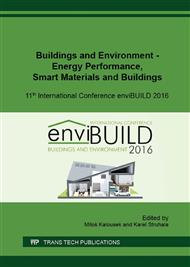p.392
p.401
p.409
p.417
p.425
p.433
p.438
p.449
p.457
The Importance of Cooperation between Heating and Ventilation in the Industry Buildings
Abstract:
Our national husbandry belongs among economies with the biggest energy consumption per an inhabitant. Slovak Republic consumes for making of product’s unit approximately twice more energy than the average in forward European countries. Such a big reserves, that we have to achieve in the area of effective increasing of energy utilization are not possible only by administrative way, but by establishing of new technical solutions into a general practice too. In a part of large-area industry operations, the new technical solution lies in the combination heating system by radiant ceiling panels with ventilation by air handling unit with integrated device for heat recovery, which considerably reduces the operation costs. Paper shows also the basic principles of heat transfer, main construction of the radiant ceiling panel and finally stated objective its advantages and drawbacks.
Info:
Periodical:
Pages:
425-432
Citation:
Online since:
December 2016
Authors:
Price:
Сopyright:
© 2017 Trans Tech Publications Ltd. All Rights Reserved
Share:
Citation:


